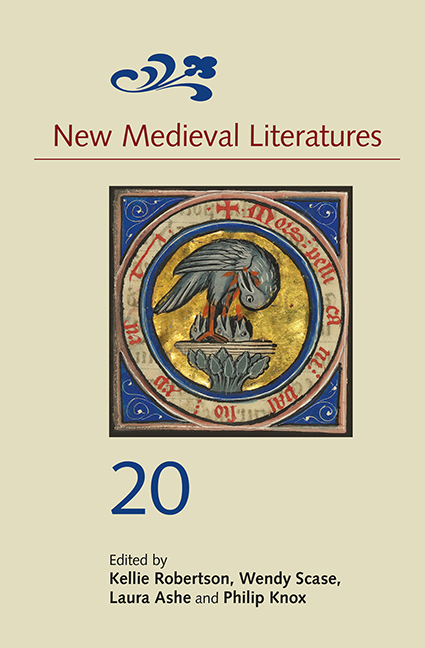Book contents
- Frontmatter
- Contents
- List of Illustrations
- List of Abbreviations
- 1 Lion-Keu-Coupé: A Missing Link in Yvain or Le Chevalier au Lion
- 2 John of Howden’s Rossignos and the Sounds of Francophone Devotion
- 3 ‘Wereyed on every side:’ Chaucer’s Troilus and Criseyde and the Logic of Siege Warfare
- 4 ‘Ave ave ave [ave]:’ The Multilingual Poetics of Exuberance in Bruder Hans
- 5 Performative Typology, Jewish Gender and Jesus’s Queer Romance in the York Corpus Christi Plays
- 6 Locating Charles d’Orléans: In France, in England and Out of Europe
- 7 Urinals and Hunting Traps: Curating Fifteenth-Century Pragmatic Books
7 - Urinals and Hunting Traps: Curating Fifteenth-Century Pragmatic Books
Published online by Cambridge University Press: 30 April 2020
- Frontmatter
- Contents
- List of Illustrations
- List of Abbreviations
- 1 Lion-Keu-Coupé: A Missing Link in Yvain or Le Chevalier au Lion
- 2 John of Howden’s Rossignos and the Sounds of Francophone Devotion
- 3 ‘Wereyed on every side:’ Chaucer’s Troilus and Criseyde and the Logic of Siege Warfare
- 4 ‘Ave ave ave [ave]:’ The Multilingual Poetics of Exuberance in Bruder Hans
- 5 Performative Typology, Jewish Gender and Jesus’s Queer Romance in the York Corpus Christi Plays
- 6 Locating Charles d’Orléans: In France, in England and Out of Europe
- 7 Urinals and Hunting Traps: Curating Fifteenth-Century Pragmatic Books
Summary
Encountering
‘A jay's feather worn as a charm
In Buckinghamshire, Stone’,
We cannot either feel that we have come
Far or in any particular direction.
James Fenton, ‘The Pitt-Rivers Museum, Oxford’Is it worth looking at everyday objects? When curators show us homely and practical things, we might well doubt, as James Fenton puts it, whether we have been taught anything new or illuminating. Is there much to admire in the ill-made, instrumental or ubiquitous? Gallerygoers have been struggling to enjoy such artefacts of the everyday for at least a hundred years, since Marcel Duchamp tried to display his Fountain, a ceramic urinal, in an art gallery in New York in 1917. As well as the shock of evoking bodily functions in public, Fountain offered the shock that it was a found thing, one not made to be put on show at all. It was a bog-standard piece of plumbing bought from a shop on Fifth Avenue. The Society of Independent Artists, refusing to display it, explained that ‘The Fountain may be a very useful object in its place, but its place is not an art exhibition and it is, by no definition, a work of art.’ As well as raising questions of propriety and imitation, Duchamp raised a question of value: can something ‘useful’ be art, something worth looking at? Is the practical pedestal worth putting on a plinth?
Art in the century since – unmade beds, facsimiles of food cartons – has sought a ‘transfiguration of the commonplace’. And a few decades of ‘thing theory’ have suggested that we should look at everyday objects: they do take us far in particular directions of thinking. But risking the question – should we bother to look at this? – might help us to look afresh at one class of everyday objects: the plain, practical manuscripts made in the fourteenth and fifteenth centuries for what is often called ‘pragmatic literacy’. Pragmatic literacy was the growing use of reading and writing for practical purposes, in documents or informational books. Take this thing (Figure 7.1): not a urinal but a manual of uroscopy, the science of diagnosing disease from the colour and consistency of urine.
- Type
- Chapter
- Information
- New Medieval Literatures 20 , pp. 216 - 254Publisher: Boydell & BrewerPrint publication year: 2020



